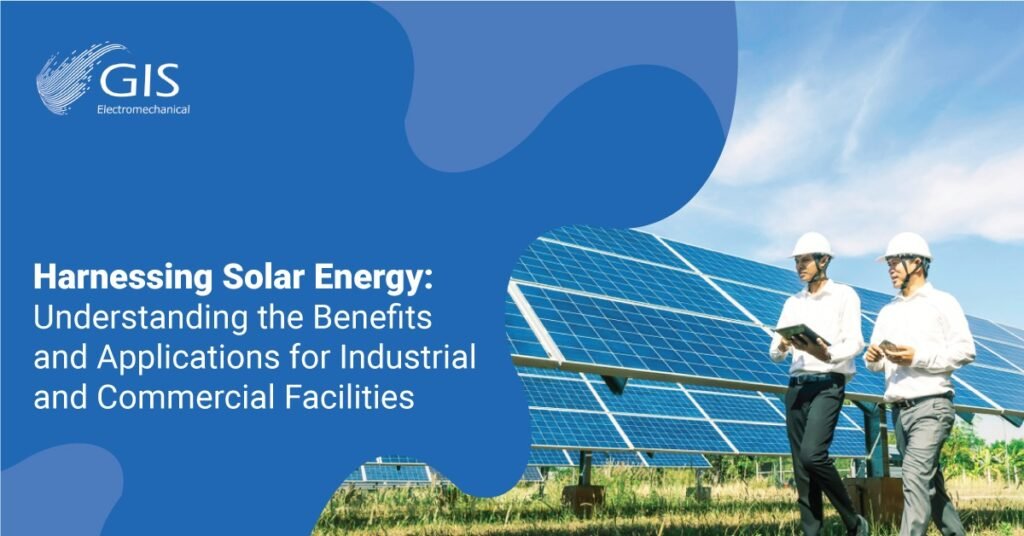Harnessing Solar Energy: Understanding the Benefits and Applications for Industrial and Commercial Facilities

As the world progresses towards a sustainable future, the use of renewable energy sources, such as solar energy, has become paramount. Solar energy is one of the most accessible and abundant forms of renewable energy, making it a prime choice for industrial and commercial facilities. This article delves into the myriad benefits and applications of solar energy in these settings, exploring how businesses can harness the sun’s power to enhance efficiency and reduce costs. The Advantages of Solar Energy Cost Savings: Solar energy significantly reduces electricity bills for industrial and commercial facilities. By generating their own power, businesses can avoid peak electricity rates and potentially eliminate their reliance on the grid. Environmental Sustainability: Utilizing solar energy reduces the carbon footprint of facilities, aligning them with global efforts to combat climate change. Solar power produces no emissions, making it an eco-friendly alternative to fossil fuels. Energy Independence: Solar installations offer a degree of energy autonomy, allowing facilities to operate even during grid outages. This is especially important for critical infrastructure and operations. Low Maintenance: Solar panels require minimal maintenance, making them a long-term investment with high returns. Once installed, they can operate efficiently for decades. Tax Incentives and Rebates: Many governments offer incentives to encourage solar adoption, such as tax credits, rebates, and grants, which can further reduce the upfront cost of installation. Enhanced Corporate Image: Embracing solar energy showcases a company’s commitment to sustainability, potentially attracting environmentally conscious clients and investors. Applications of Solar Energy in Industrial and Commercial Settings On-Site Power Generation: Installing solar panels on rooftops or surrounding land allows facilities to generate their own electricity, reducing utility costs and increasing energy reliability. Solar Thermal Systems: These systems capture sunlight to heat water or air for industrial processes or space heating. This can lead to significant energy savings in operations such as manufacturing. Solar Lighting: Solar-powered lighting systems offer energy-efficient solutions for outdoor and indoor lighting. This includes streetlights, parking lot lights, and signage. Solar Charging Stations: For businesses with electric vehicle fleets or for customer use, solar charging stations provide a sustainable way to power vehicles, reducing reliance on the grid. Agricultural Applications: In agricultural settings, solar energy can power irrigation systems, greenhouse operations, and other farm machinery, contributing to increased productivity and sustainability. Remote Power Supply: For facilities in remote locations without easy access to the grid, solar power provides a viable and often more cost-effective alternative for electricity generation. Steps for Implementing Solar Energy in Facilities Assess Energy Needs: Evaluate the energy consumption patterns of the facility to determine the appropriate size and type of solar system required. Site Survey and Design: Conduct a site survey to identify the best locations for solar panel installation, considering factors such as sunlight exposure and space availability. Choose the Right Technology: Select solar technology based on the facility’s needs, such as photovoltaic (PV) panels for electricity generation or solar thermal systems for heating. Secure Permits and Incentives: Obtain the necessary permits and approvals for installation, and take advantage of any available financial incentives. Installation: Hire a qualified solar installation contractor to ensure a safe and efficient setup. Monitoring and Maintenance: Regularly monitor the solar system’s performance and conduct routine maintenance to maximize efficiency and longevity. Harnessing solar energy offers industrial and commercial facilities numerous benefits, from cost savings and energy independence to enhanced corporate image and environmental sustainability. By carefully evaluating their energy needs and implementing the appropriate solar solutions, businesses can take a significant step towards a greener and more efficient future.
